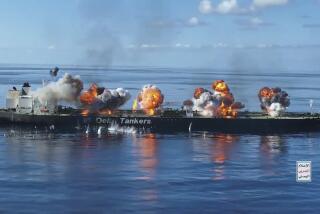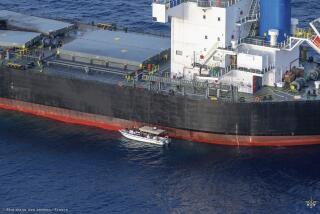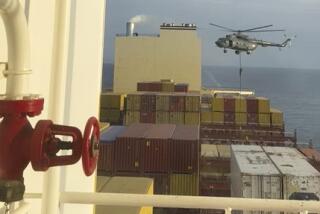4 More Mines Found Outside Persian Gulf
- Share via
FUJAIRA, United Arab Emirates — Four mines believed to have been laid by Iran bobbed to the surface in the waters off this busy seaport Tuesday, expanding the perimeter of the Persian Gulf conflict and enlarging the concern for international shipping in the region.
As the huge black and white mines were spotted near the entrance to the Persian Gulf, a three-tanker convoy escorted by U.S. Navy warships reached its destination at the northern end of the waterway, Kuwaiti waters off the Al Ahmadi oil loading terminal. The convoy, which had secretly slipped out of Fujaira on Saturday, had been delayed for more than a day by the discovery of newly laid mines in its path.
Shipping sources said U.S. Navy helicopters discovered and destroyed at least two mines in the waters near Iran’s Farsi Island, 120 miles southeast of Kuwait. The supertanker Bridgeton hit a mine July 24 in that general area during the first Navy-escorted convoy to Kuwait.
The mining reports appeared to suggest that despite increased vigilance by U.S. warships, Iranian gunboats have been active at both ends of the gulf, laying mines without hindrance or fear of detection.
A crisis atmosphere prevailed in the shipping industry here after the mine explosion on Monday that damaged the American-owned supertanker Texaco Caribbean. This vessel was entering the Fujaira anchorage about eight miles off the coast of the United Arab Emirates in the Gulf of Oman, the body of water just outside the Persian Gulf.
The Texaco Caribbean blast marked the first time a ship has been damaged outside the Persian Gulf in almost seven years of war between Iran and Iraq.
After the explosion, oil from the fully loaded tanker poured out a 12-foot hole in the ship’s left side, spreading an enormous stain on the aquamarine waters. By Tuesday, the crew of the tanker, which flies a Panamanian flag of convenience, had succeeded in stopping the leak by transferring petroleum in the ruptured tank to other holds.
At the time of the explosion on Monday, officials had speculated that the mine might have drifted southward from Iranian waters or the entrance to the gulf--the Strait of Hormuz--during four days of naval exercises that the Iranians code-named “Martyrdom.” The exercises ended Friday night.
But as the new mines appeared in the Fujaira anchorage, shipping officials said it now seemed clear that the mines had been planted by Iranian boats in the past 48 hours.
Officials said the currents of the Gulf of Oman at this time of year run toward the Strait of Hormuz, thus precluding the possibility that the mine had drifted from Iran.
One mine, its huge detonators protruding like fingers, looked like an abandoned beach ball rolling gently in the swell. It was discovered tethered just five miles off shore, less than 200 yards from an anchored Greek tanker, the 127,000-ton Kymo.
Three other mines were spotted from helicopters, apparently drifting 11 miles offshore. The water is 250 yards deep in the area, too deep for a tethered mine.
Emirates authorities, clearly alarmed at the possibility that the mining could abruptly end the lucrative shipping traffic at Fujaira, clamped a news blackout on the discoveries. But as warnings crackled over ships’ radios, it became harder to keep the situation quiet.
“Fujaira is not closed,” the harbor master, Capt. Roger Turnbull, insisted. “At the first indication that the port of Fujaira has a danger to shipping, we will advise them.”
There are about 45 ships riding at anchor here and another 15 to the north in the waters off the port of Khawr Fakkan. Some are carrying loads of crude oil that their owners hope to sell at a price higher than they paid, and others are standing empty, waiting for the market price of oil to go down.
After the Texaco Caribbean was struck, shipping officials quickly predicted that any more sightings of mines would cause insurers to impose higher war-risk rates for ships anchored in Fujaira, perhaps curtailing the port’s role as the nearest safe harbor to the Persian Gulf. On Tuesday, London ship insurers announced such added premiums on vessels sailing to the ports of Fujaira and Khawr Fakkan.
Officials were puzzled by Iran’s apparent action in laying the mines here, since the rise in insurance rates will affect Iranian shipping as well.
They noted, for example, that the first victim of the new mining, the Texaco Caribbean, had been carrying crude oil picked up just hours before from Iran’s Larak Island oil terminal in the Strait of Hormuz. The incident, they say, illustrates how indiscriminate mines are; serious disruption of shipping in the gulf region could make customers of Iranian oil seek alternative suppliers from areas where they can safely take delivery.
In its first comment on the mining of the Texaco Caribbean, Iran said Tuesday that the mining was “a U.S. plot for suggesting insecure conditions in the Persian Gulf.”
One explanation for the action may be that the Iranians hope to serve an unmistakable warning to the Emirates--generally neutral in the Iran-Iraq conflict--to keep from tilting toward Iraq.
Emirates officials were quick to condemn Iran last week for its role in the violent disturbances during the annual Hajj pilgrimage to the Saudi Arabian holy city of Mecca, in which more than 400 people died.
More importantly, the United States has used the Fujaira anchorage to assemble the two convoys of reflagged Kuwaiti merchant ships that it has escorted into the Persian Gulf. There is no other convenient assembly point nearby.
“The port of Fujaira is a very important source of income for the Emirates,” said one shipping official. “Restricting its use is having tremendous political ramifications. It’s as bad as mining the Strait of Hormuz.”
This concern was apparently reflected Tuesday when the U.S. ambassador to the Emirates, Robert Mack, and the British consul general in Dubai met Sheik Mohammed ibn Rashid al Maktum, the Emirates’ defense minister, who reportedly expressed great concern that the country was being drawn into the gulf conflict against its will.
At the other end of the gulf, four U.S. warships peeled off from the three Kuwaiti tankers they had been escorting as the convoy reached Kuwaiti territorial waters. The three tankers have been re-registered in the United States as part of President Reagan’s program to provide protection to 11 Kuwaiti ships in all.
More to Read
Sign up for Essential California
The most important California stories and recommendations in your inbox every morning.
You may occasionally receive promotional content from the Los Angeles Times.










